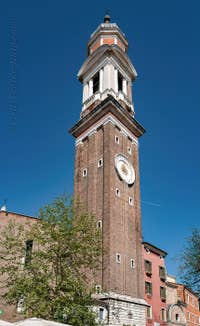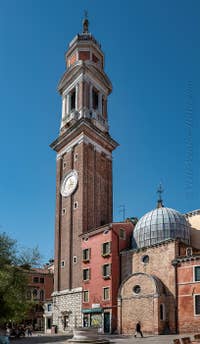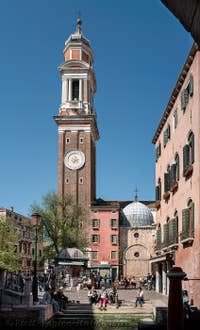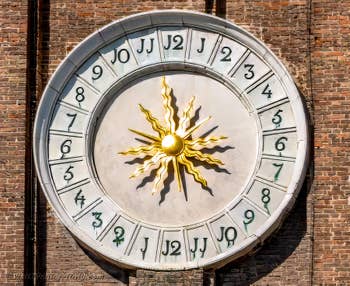Bell Towers Saint-Mark | Greci | St.Giorgio | Formosa | Apostoli | Stefano | Vigna | Felice |
The Campanile dei Santi Apostoli in Venice
Height: 47 metres

Campanile SS. Apostoli The Campanile dei Santi Apostoli, located in the Cannaregio district of Venice, is a beautiful 47-metre high campanile.
According to some, the church and its first campanile, were built in the 7th century, but, according to others, this construction only dates from the 11th century.
Which means that this Campanile, or at least its predecessor, was already part of the Venetian landscape from the very origins of Venice.
From destruction to construction
The first church and its bell tower were destroyed by fire in 1105.In 1450, the shaft of the campanile, its "trunk" was rebuilt. At that time, however, there was still no bell chamber.
Its base is made of Ionian stone. Its base is made of Istrian stone, while the tower, the "trunk", is made of brick. The campanile can be seen on Jacopo de Barbari's 1500 plan of Venice.
In this drawing, you can see that the campanile tower has two vertical bands, just like today's campanile, and that the shaft is topped by a low wall with three openings in which the bells were installed.

Campanile SS. Apostoli A bell chamber was built later, but this was destroyed in a hurricane in 1659.
In 1672, according to some, the shaft, the trunk of the bell tower, was rebuilt. For others, it was the bell chamber that was rebuilt...
In any case, it was in 1672 that Guiseppe Tassini records the accident that befell Domenico Longo, known as Bachetin, an elderly priest who was responsible for rebuilding the bell tower.
According to Tassini, but not according to Tassini, it was the bell chamber that was rebuilt. According to Tassini, but this seems to us to be more the stuff of legend than truth, a priest called Domenica Longo fell from the Campanile by sliding down from the bell chamber, which would mean that it was already there! The poor priest may well have been frightened to death, as his clothes (again conditional) got caught on one of the hands of the clock, where he hung there until someone came to his aid.
In addition, the clock face on the Campanile is said to have been made of stone. It should be added that the dial on the campanile dei Santi Apostoli is a 24-hour dial, which means that the hand that saved him was moving very slowly, so that he could be rescued before the clock ran out of time! To cut short the inconsistencies in dates relating to the construction of the bell chamber, let's just say that the bell tower was completed in its current state between 1672 and 1720.
The bell chamber and the bulbous top of the bell tower were designed by the architect Andrea Tirali

Campanile SS. Apostoli The dome and bulb of the campanile dei SS. Apostoli was destroyed by lightning on 28 October 1779.
Without steps, in brick and Istrian stone
The base of the campanile is made of Istrian stone, while its quadrangular shaft is made of brick. The shaft is surmounted by a wide cornice of Istrian stone, on which the bell chamber rests.This bell chamber is quite unusual. The bell chamber is quite elegant, with its eight columns and four small balconies allowing visitors to step out of the bell chamber to admire the view.
The bell chamber is topped by a large cornice in Istrian stone. The bell chamber is topped by a bulbous dome, covered in lead.
Another feature of the Campanile dei Santi Apostoli is that there are no steps to reach the top. Instead, gentle brick slopes are used to climb to the top.
The same principle had also been applied to the former Campanile of St. Mark.
Clocks and Bells
According to the historian Cesare Auguste Levi, the clock was restored in 1820 and the bells were all replaced in 1840.During our visit to the campanile in 2011, we noticed that all the bells in the lower section, those at ground level, bore the date 1907, as did the clock mechanism itself, built in Milan by Cesare Fontane.

Dial of the Campanile This mechanism did not rust and was replaced, as were the bells, by an electromechanical system.
Venice time: A very... Venetian way of counting the hours !
À In Venice, the twenty-four hours of the day did not begin at midnight, but at the Angelus prayer, half an hour after sunset.In other Italian cities, we were half an hour ahead of Venice, since it was at sunset that the next day began.
This meant that, depending on the season and the movement of the sun throughout the year, the clocks, including of course those on the bell towers, were constantly moved forward or back.
- The time remained the same in January, June, July and December.
- The time was changed twice a month in February, March, August, September and November.
- We changed the time three times a month in April and October.
It was only after Napoleon Bonaparte invaded Venice that this way of counting the hours in Venice, which was over a thousand years old, was replaced by the so-called French time.
A Campanile that tells the time again thanks... to the French !
Since 2010, French students from the Lycée d'Altitude in Briançon, under the direction of Denis Vialette, assisted by Dominique Dion and Stéphane Ferraris, specialists in building clocks, have been maintaining the clock on the Campanile dei Santi Apostoli.As mentioned above, the hours are displayed on a 24-hour dial, which means that the hour hand only goes round the clock once a day.
To read it, you only need to look at the clock face. To read it, you only need to look at the largest of the hands (there is no minute hand, the others are merely decorative and represent the sun's rays). The right-hand part of the dial therefore goes from noon to midnight (the 12 at the bottom of the dial) and the left-hand part from midnight to noon (the 12 at the top of the dial).
This bell tower is not open to the public and unfortunately cannot be visited.
Bell Towers Saint-Mark | Greci | St.Giorgio | Formosa | Apostoli | Stefano | Vigna | Felice |
Back to Top of Page

